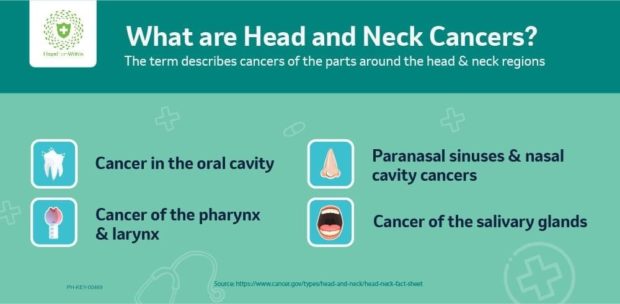Cancer can start almost anywhere in the human body. That is why there are many types of cancers, from the common to the rare kinds, April is Head and Neck Cancer awareness month.
There are at least 7,000 Filipinos diagnosed with head & neck cancers in a year. Although this only makes up around 4.7% of the new cancer cases in country, head & neck cancers continue to be a burden on Filipino families experiencing it.
Medical oncologist Dr. Eugene Regala, from the Philippine Society of Medical Oncology (PSMO) breaks down exactly what head and neck cancers are, the risk factors, and treatment options for the disease.
What are head and neck cancers and how do you get them?
Head and Neck Cancers refers to cancers on the upper aerodigestive tract. This involves the oral cavity, pharynx, larynx, nasal cavity and paranasal sinuses and salivary glands.

Breakthroughs in research and important strides by the health care community in preventing, detecting, and treating cancer, have contributed to the decrease in incidence of head and neck cancers in the past three decades. However, cases of HPV-associated oropharyngeal cancers have noticeably increased to almost 200 percent from 1988-2004, particularly among younger patients with no significant smoking history.
Smoking, including tobacco or betel nut chewing, and alcohol are some of the major risk factors for this type of cancer. Long-time smokers are 5 to 25 times more likely to develop cancer of the larynx and pharynx.
Excessive consumption of alcohol is known to increase one’s risk to different types of cancers including mouth and throat.
Other risk factors are occupational exposure to asbestos, pesticides, and dry-cleaning agents among other hazardous chemicals; prior radiation therapy for benign and malignant cancers; genetic factors; and Epstein-Barr virus (EBV).
Is HPV related to head and neck cancers?
Human papillomavirus (HPV) is most commonly associated with cervical cancer. Infection with high-risk HPV has been recently implicated in the development of head and neck cancers.
The rising incidence of oropharyngeal cancers among younger men, even with those who are not heavy or non-consumers of tobacco products and alcohol, can be traced to HPV (type 16) infection. A higher frequency of oral sex and a greater number of sex partners are thought to increase the risk of HPV related cancer.
What are the common symptoms?
Physical symptoms of head and neck cancers are white or red patches on the gums, tongue or lining of the mouth. Also, watch out for are mouth ulcers that do not heal or any unusual bleeding.
Other possible symptoms are chronic sinus infections that do not respond to antibiotic treatments, frequent headaches and swelling or eye pain, any mass on the mandibular area or the bone that holds the lower teeth, facial numbness, ear pain or any growth in the ear.
Importance of early detection and treatment available
Having any symptoms mentioned above does not automatically indicate cancer. But early detection is extremely important so that any malignancy can be treated at its earliest stage for excellent prognosis.
At present there is no specific screening method that has been proven to improve survival among patients. However, doctors recommend yearly physical examination and dental evaluation specially for people with average to high risk. Neck examination and inspection of the oropharynx and mouth are highly advised.
Early detection is associated with choosing the type of treatment should screening yield a positive result because different stages of cancer require different combinations of treatment. A combination of chemotherapy and radiation treatment are usually proposed for localized cancer; multiple lines of chemotherapy for metastatic (when cells that have spread to other areas) or recurrent disease; or surgery to remove an existing tumor.
While many patients with locally advanced disease are cured with some combination of surgery, radiation and chemotherapy, other patients will develop recurrent or metastatic disease and are considered incurable. There are other treatment options to be considered by head and neck cancer patients such as immunotherapy and targeted therapy. Immunotherapy is a type of cancer treatment that activates one’s immune system to fight cancer. Meanwhile, targeted therapy uses drugs designed to “target” cancer cells without affecting normal cells.
Achieving quality of life in cancer treatment
All treatments are tailor-fitted to each individual patient. Head and neck cancers are very debilitating most particularly in its advanced stages. Patients are always advised to consult with specialists at the first symptom.
He emphasizes that considering the impact of treatments to the quality of life of the patients is equally critical as survival rate. In treating cancer patients, we should not only focus on their response to treatment but rather holistically on how the treatment is affecting their everyday life. Because most of the time, being able to carry out activities of daily living is much more important than the other parameters we measure in treatment response.
Doctor-patient rapport is also a significant aspect in the holistic management of head and neck cancers. Dealing with a patient’s emotion is critical to their well-being. Empirical data suggests that a physician’s caring attitude is a therapeutically important aspect of the relationship.
To learn more about Head and Neck cancers please visit Hope From Within https://hopefromwithin.org/
ADVT
Read more Lifestyle stories:
Customer review: Clear vision contact lenses
Fujidenzo introduces new portable aircon with air purifying filters
Save more on electricity bills with Whirlpool’s new Inverter Refrigerator